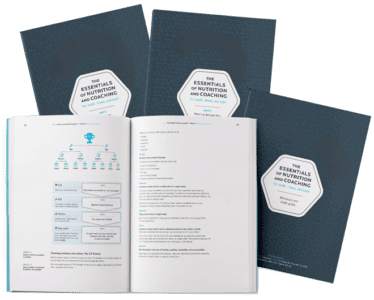Chapter 8
How to intermittent fast: A step-by-step guide
Many people search for detailed rules to help them learn how to intermittent fast. Poring over the “rules” won’t get you anywhere, though. A better strategy is to try a schedule and see how it goes, collecting data about your experience along the way and making adjustments as needed. Here’s a framework for doing just that.
Key concepts
- Experimentation helps you learn what’s right for you. At Precision Nutrition, we teach our clients (and coaches) how to explore nutritional ideas by testing them in real life. Rather than following someone else’s rules, you get to explore and develop your own.
- Self-experiments keep us moving forward. This in turn creates sustainable change and growth.
- For best results, have a clear goal and follow a systematic process. This includes defining a research question and progress indicators, tracking yourself closely, and adjusting as needed. Have a plan and know when to change or abort the mission.
- Make your first experiments or actions as simple and small as possible. Keep other elements of your routine consistent, so you can determine what’s working (or not).
- If possible, get coaching and support along the way. Outside perspective and expertise enhances your learnings.
At Precision Nutrition, we’re big fans of something called outcome-based decision making.
It involves making decisions based on results and data.
When it comes to intermittent fasting (IF), we use outcome-based decision making to help clients figure out whether a specific intermittent fasting schedule is right for them.
The key feature of outcome-based decision making: Experiments.
By running experiments, learning from the results, and making adjustments as needed, our clients increase their chances of succeeding long term.
These experiments are nothing fancy. If you explored the scientific method in science class, then you probably already have an idea of how to do one. Either way, we’ll walk you through the process below.
And if you still feel unsure, consider getting coaching. A coach is much more able to take an objective view, consider the data neutrally, and offer you appropriate feedback on what to do next.
Step 1: Choose an intermittent fasting schedule.
Before you run your experiment, you need something to test, which means you’ll need to know which IF schedule you plan to follow. (See chapter 6 for a complete rundown of all the IF schedules.)
As a general rule, you’ll want to err on the side of picking a schedule that’s too easy to follow rather than one that’s too hard.
If you’ve never tried any form of fasting, you’ll probably want to start with skipping a meal—or even just delaying one meal by an hour or two.
If you’re a fasting veteran, on the other hand, pick something that’s just a little bit harder than what you’ve successfully tried in the past.
You want to end up with something you’re at least 90 percent confident you can ace.
And if you’re worried about it being too easy, remember: You can always make it more challenging in the future.
No matter which IF schedule you choose, use this advice:
- Try not to think of your non-fasting/non-restricted period as an “all you can eat” buffet. Except for specific circumstances (such as doing IF for muscle mass gain or extreme body composition changes), you just want to eat normally. (You’ll read more about this in step 2).
- Resist any urge to overachieve at fasting. As we’ve mentioned before, more fasting is not better. Going without food and nutrients for too long or too often raises your risk of deficiencies, hormonal problems, and burnout.
- Make your schedule fit your life, rather than the other way around. Consider how much work, preparation, and regimentation any particular plan might require. Choose your IF schedule in that context.
- Don’t forget to drink water. This is crucial during your fasting periods.
- Go easy on your workouts. Remember what you learned about working out and IF in chapter 7. Exercise is one stressor. IF is another. If you take on too much at once, you can run your body into the ground, so to speak.
Step 2: Decide what you’re looking for.
What is the biggest thing you want IF to do for you? Is it fat loss? A better relationship with hunger? Something else?
When our company co-founder John Berardi, PhD, embarked on a series of IF experiments, he had several goals. But his most important one was to lose body fat.
That’s how he defined success (even if the trade-offs might have included feeling mentally fuzzy or annoying his family).
So take time to figure out what you want to explore, learn, and accomplish with IF. You might also want to identify what you’re willing to trade off for your goal.
For help, check out our “Want, willing, won’t” worksheet.
Optional step: Use our calculator to determine your intermittent fasting macros.
Whether your goal is fat loss, better health, muscle gain, or something else, it’s not just about when you eat.
What and how much you eat matters, too,
Some people may be able to eat the right amount for their goals intuitively, but most of us need a little extra help, at least at first. (To learn why, see this article comparing macros, calories, hand portions, and intuitive eating.)
(If adding calorie, macro, or hand portion tracking feels like way too much in addition to starting a new IF schedule, feel free to come back and add this element later.)
To find out how much to eat—and get some suggestions about which foods to prioritize based on your eating preferences—use the Precision Nutrition Calculator.
It’ll tell you how much to eat based on your age, sex, goal, and desired timeline (within reason!).
Nutrition CalculatorHow much should you eat? Let’s find out.© Precision Nutrition
An important note: This calculator will give you a suggested daily intake of calories, macros, and hand portions.
- If you’re doing skip-a-meal fasting or time-restricted feeding, you’re good to go with the calculator’s results. Aim for the daily intake it provides.
- If you’re doing a form of IF that involves varying how much you eat from day to day, multiply your daily intake result by seven to get your weekly nutritional goals. After that, you’ll need to do a little more math. For instance, if your results say you should eat 2000 Calories a day, your weekly intake would be 14000 Calories. If you’re fasting completely one day per week, you’d take 14000 and divide it by your six eating days, which equals approximately 2333 Calories. So on your non-fasting days, aim for that intake.
Step 3: Determine how you’ll measure your outcome.
What does success look like? How will you know whether you’re moving in the right direction, and when you’ve arrived at your goal?
Here are just a handful of indicators to consider:
- energy level
- body fat loss
- athletic performance
- recovery
- mood and wellbeing
- blood work
- blood pressure
- pain and/or inflammation
- mobility and/or joint stiffness
- sleep quality and/or duration
And so on.
Once you choose your indicator(s), decide how you’ll measure it, as well as how often.
Fat loss? That’s pretty easy. You can go by scale weight, girth measurements, and/or body fat measurements. But let’s say you want to improve your energy levels. You can’t just drop by the local pharmacy to pick up an “energy scale.”
So you’ll have to come up with something. Maybe you create a 10-point scale with 0 being no energy and 10 being the most energy you’ve ever felt. Then you rank your energy every day at the same time by placing an X on the area of the scale that best represents how you feel.
We suggest monitoring your indicators as often as possible (so you can tell fairly soon if something needs changing).
But keep it easy.
The most perfect indicators won’t matter if you can’t or won’t check them consistently.
Step 4: Gather evidence.
If your goal is something you can measure easily, such as running a faster mile, you can probably jump right into your experiment.
If it’s something less palpable—such as energy levels or mood—it may be a good idea to collect at least a week or two of “normal life” data. This will serve as a baseline, helping you to more easily see what changed when you started IF.
Once you know your baseline, spend at least two weeks fasting and gathering data.
That’s usually enough time to give your schedule a chance to produce a measurable result. Your goal here is to follow your schedule consistently for long enough to identify a trend.
And this next part is super important:
As much as possible, try not to change any other variables during your fasting experiment.
If you change too much at once, you won’t know what worked—or what didn’t. So, while you’re running your experiment, try to keep your training, weekly calorie intake, stress levels, any supplements you take, and other variables as consistent as possible.
Step 5: Review and interpret the evidence.
Ask yourself:
- How is IF working for you? Consider using this quick and easy quiz to put a number on it.
- Did your schedule help you achieve the outcome you set for yourself?
- Were you able to follow your schedule 80-90 percent of the time?
- And how did you feel? Was this something you feel like you could stay with long term? Or did it take everything you had just to last a couple weeks?
Step 6: Based on evidence, decide on next steps.
If the data show you’re going in the right direction, keep doing what you’re doing. Clearly this is working for you.
But if you found your IF schedule impossible to stick to and/or you didn’t reach your desired outcome:
Don’t drive faster down the wrong road because “it should work.”
The data are telling you that it’s time to change course.
Go back and repeat the process, starting at the very beginning.
If you had trouble sticking to a schedule consistently, consider ways to make it easier. Maybe instead of fasting for a full day once a week, you only fast for half a day.
If you were able to stick to your plan, but you didn’t see any measurable changes, consider why—as well as what might help.
- Was it too stressful for your body? If so, you’ll want to ease up, either backing off on exercise and other life stressors or attempting a gentler fasting style.
- Was it too easy? Maybe the IF schedule you tested just wasn’t enough of a change for you. If that’s the case, you might want to experiment with a more advanced fasting schedule.
The more objective and analytical you are, the more accurately you’ll understand what happened. From there, you’ll be able to make a wise decision about what to do next.
Keep in mind that you may need to embark on several experiments before you get IF just right.
And that’s okay.
If possible, get some support.
We recommend working with a coach.
An experienced coach will be able to help you understand your motivations and priorities, set clear and realistic goals, decide how to measure progress metrics properly, and evaluate your results appropriately.
Working with a nutrition professional turns “self-experimentation” into “guided experimentation,” something that usually moves the process along much more effectively… and makes it more fun.
To find a certified nutrition coach, check out our coaching directory.
This is a simple, powerful process.
It’s easy to get lost in the details of specific IF schedules—obsessing over a set of rules, created by someone else, that you must follow… at all costs.
For many people, that’s often a recipe for disappointment.
On the other hand, self-experimentation allows you to come up with your own rules based on your own data, in your own life. And you can use it to continually learn new things about yourself. There’s always a next step and never a dead end.
Mastering self-experimentation makes you the expert, and boss, of your experience.
You’ll start feeling in control—of your decisions and your ability to revise and refine your own life.
Best of all: you’ll eventually find the eating style, whether it’s IF or something else, that works perfectly for you.





